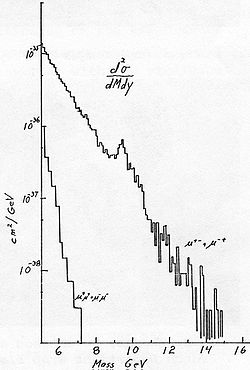Upsilon meson
The Upsilon meson (ϒ) is a quarkonium state (i.e. flavourless meson) formed from a bottom quark and its antiparticle. It was discovered by the E288 experiment team, headed by Leon Lederman, at Fermilab in 1977.[1][2] It has a lifetime of 1.21×10−20 s and a mass about 9.46 GeV/c2 in the ground state. Overview There are many species of bottomonium known, but the ones generated by e-e+ colliding beams (or proton-nucleus collisions decaying to →μ+μ- + X) are the ones generally referred to as upsilon mesons.[3][4] Thus, among the bound bb bottomonium species, the S-state[a] triplet[b] resonances are identified as upsilons, and are assigned the shorthand notations ϒ (S1), ϒ (S2), ϒ (S3), etc.,[c] where the numbers 1, 2, 3 represent the principal quantum number n. [5][d] Alternately, the notation parenthesizing the measured mass in MeV is used, e.g. Υ(10860).[6][7] In the narrow sense, "Upsilon particle" refers strictly to the Υ(1S).[9] As clear from its quark structure, the Upsilon meson carries no charge or flavor, and has 0 isospin. The zero spin state should have a lighter mass by about 0.1 to 1% according to quantum chromodynamics.[citation needed] DiscoveryLederman's E288 experiment team at Fermilab had made a preliminary finding of a resonance at 9.5 Gev in November 1976, but was more reticent in announcing it because earlier they had prematurely announced a 6 Gev resonance event (which they were planning to name upsilon; cf. Oops-Leon) with their equipment in dielectron (e+e-) mode; this find did not pan out and ultimately could not be confirmed.[10][1][11] However, with their equipment converted to dimuon (+-) mode with increased sensitivity upped 100 times, they began measurement in May 1977 and clearly confirmed resonance peaks at 9.4/9.5. 10. 10.4GeV (cf. § Resonance states under S1, S2, S3)[e][12] [1] These peaks were verified by the German team using DESY's DORIS storage ring.[8][13] The upsilon was the first particle containing a bottom quark to be discovered because it is the lightest that can be produced without additional massive particles.[citation needed][f] Resonant statesΥ(1S)Mass measured at 9460.30±0.26MeV (Lawrence Berkeley National Laboratory, Particle Data Group, 2008)[15] Lifeime of about > 10-20 [17] calculated from measured energy width to 1.21×10-20s.[18][20] The types of decay modes are diverse, with electron pair, muon pair, tauon pair decays (all three lepton decays) each occurring at 2.5% frequency.[15] The short lifetime (τ) is calculable from the usual formula τ ΔE= h/2π, so in the subsequent sections, the listing of the lifetimes will be eschewed. Υ(2S)Mass measured at 10.02326±0.00031GeV[21]。 Here again, decay modes are diverse, decaying into Υ(1S) and charged pion pair, approx. 20% of the time, into Υ(1S) and neutral π pair, approx. 10%, and into lepton (e、μ、τ) pairs, about 2% each.[21] A B-factory at SLAC's PEP-II accelerator postponed the termination of operation by 2 months to conduct experiments starting February 2008 to generate Υ(2S) and Υ(3S) (cf. below). While the data remained to be fully analyzed, the team announced in the fall of 2008 that they discovered the spin 0 ground state bottomonium corresponding to the spin 1 Υ(1S) state. The published mass difference with Υ(1S) was 71.4+2.3−3.1±2.7MeV.[22] Υ(3S)Mass measured at 10.3552±0.0005GeV[23] Again, diversely decaying into Υ(2S)+X (such as pion pairs), approx. 10%、Υ(1S)+X (such as pion pairs), also lepton (μ、τ) pairs, about 2% apiece, but e+e^ decay is quite rare.[23] Υ(4S)Also called Υ(10580)とも呼ばれる。質量は、10.5794±0.0012GeV[24]。 Nearly completely decays (>96%) into B meson pairs, almost fifty-fifty between charged pairs and uncharged pairs.[24] Thus for B meson research, this Υ(4S) mode of resonance is of great importance, and its research has been undertaken by various B-factories (up to c. 1999).[25]。 Υ(10860)Also called Y(5S).[6]。 Measured mass of 10.865±0.008GeV[7] Main decay mode into B meson pairs only or with 1 or 2 pions, about 60% of the time, and into charm B meson pairs, about 20% of the time.[7] In this 2008 data report, the strange B meson (B Υ(11020)Mass measured at 11.019±0.008GeV.[26] The decay modes are unclear except a small percentage of electron pair decays, as of 2008.[26]。 See also
Explanatory notes
ReferencesCitations
Bibliography
|
||||||||||||||||||||||||||||||||||















